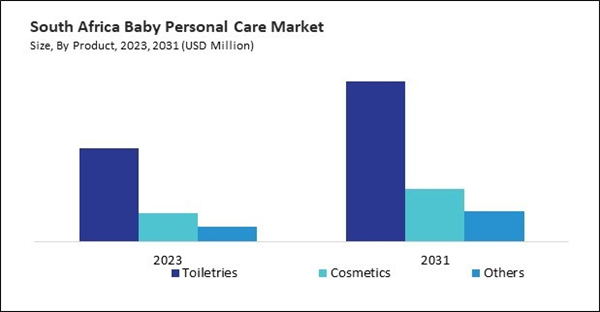Online distribution channels play a crucial role in the market by offering convenience, accessibility, and a wide range of options to parents and caregivers. These channels provide a platform for parents to research products, compare prices, and read reviews, empowering them to make informed decisions about the care of their infants. Consequently, the Online distribution channels would register the demand of these products to 339.4 million units in Brazil by 2031.
The Brazil market dominated the LAMEA Baby Personal Care Market by Country in 2023 and would continue to be a dominant market till 2031; thereby, achieving a market value of $4,592.7 Million by 2031. The Argentina market is showcasing a CAGR of 9.1% during (2024 - 2031). Additionally, The UAE market would register a CAGR of 8.2% during (2024 - 2031).
The market is dynamic and constantly evolving, driven by changing consumer preferences, technological advancements, and societal trends. Several notable trends are shaping the market landscape, influencing product development, marketing strategies, and consumer behaviour. For instance, a growing demand for natural and organic baby personal care products is driven by increasing health awareness, environmental sustainability, and ingredient transparency.
Brands are increasingly focusing on sustainability and eco-friendliness in packaging design and materials. Biodegradable packaging, recyclable materials, and refillable options are gaining popularity as consumers become more conscious of plastic waste and environmental impact. Sustainable packaging appeals to environmentally conscious consumers, reinforce brand values and fosters loyalty.
Rising retail sales indicate a growing economy and increased consumer purchasing power, leading to higher demand for such products. As more Brazilian families have disposable income to spend on baby essentials, the market expands, driving overall growth in the industry. According to the Brazilian government, seasonally adjusted series, retail trade sales increased by 1.0% in January 2024 from December in Brazil. In conclusion, the growing retail sales and rising e-commerce sector in the region propel the market’s growth.
Based on Product, the market is segmented into Toiletries, Cosmetics, and Others. Based on Distribution Channel, the market is segmented into Hypermarkets & Supermarkets, Online, and Specialty Stores & Others. Based on countries, the market is segmented into Brazil, Argentina, UAE, Saudi Arabia, South Africa, Nigeria, and Rest of LAMEA.
List of Key Companies Profiled
- L'Oreal S.A.
- Dabur India Ltd.
- Abbott Laboratories
- Unilever PLC
- The Procter & Gamble Company
- Kimberly-Clark Corporation
- Johnson & Johnson
- Beiersdorf AG
- Himalaya Wellness Company (Himalaya Global Holdings Ltd.)
- Avon Products, Inc. (Natura &Co Holding S.A.)
Market Report Segmentation
By Product (Volume, Million Units, USD Billion, 2020-2031)- Toiletries
- Cosmetics
- Others
- Hypermarkets & Supermarkets
- Online
- Specialty Stores & Others
- Brazil
- Argentina
- UAE
- Saudi Arabia
- South Africa
- Nigeria
- Rest of LAMEA
Table of Contents
Companies Mentioned
- L'Oreal S.A.
- Dabur India Ltd.
- Abbott Laboratories
- Unilever PLC
- The Procter & Gamble Company
- Kimberly-Clark Corporation
- Johnson & Johnson
- Beiersdorf AG
- Himalaya Wellness Company (Himalaya Global Holdings Ltd.)
- Avon Products, Inc. (Natura &Co Holding S.A.)
Methodology

LOADING...









